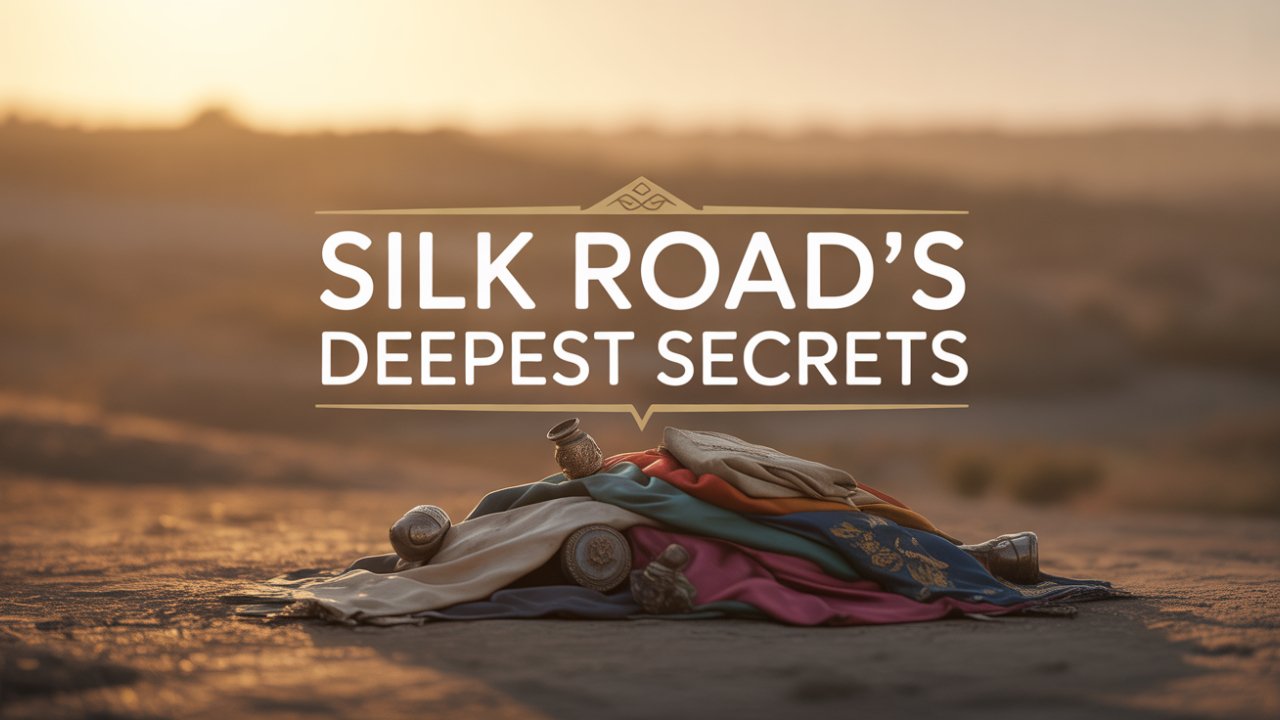Say the words “Silk Road,” and what pops into your head? Probably a pretty romantic image, right? A single caravan of camels, loaded with shiny silks and fragrant spices, trekking across some endless golden dunes. For centuries, that’s the story we’ve been told. A simple, almost peaceful superhighway of trade connecting East and West.
But what if that story is mostly a myth? What if the real history of this ancient network is far more complicated, more violent, and way more influential than we’ve been led to believe? And what if the most valuable things being traded weren’t things you could hold, but invisible cargo that would reboot entire civilizations? The true story of the Silk Road isn’t really about silk. It’s a story of secret wars, forgotten empires, and world-changing ideas buried under the sands of time. This is the untold story of the Silk Road’s secrets.
The classic image of the Silk Road is a single line on a map. But the reality was a messy, sprawling web of trails, crisscrossing both land and sea, spanning the whole of Eurasia. This network was the circulatory system of the ancient world, and its lifeblood pumped through huge, cosmopolitan cities. We know the famous ones: Samarkand, Bukhara, and the great Chinese capital, Chang’an, now known as Xi’an. These were the glittering hubs of culture and commerce. But for every one of those, countless others have been lost to history, swallowed by the deserts that flanked the routes. And these lost cities hold the first secret: the Silk Road wasn’t just a path, it was a chain of man-made oases that literally reshaped the landscape of the ancient world.
Take the Taklamakan Desert in Northwest China. Its name is often said to come from a local Uyghur phrase meaning, “You can go in, but you can’t come out”—a popular folk etymology that perfectly captures its deadly reputation. And yet, for centuries, this exact desert was dotted with thriving city-states, absolute monuments to human ingenuity. But their existence was fragile. A tiny shift in a river’s course, a bit of political drama, or a change in trade routes could mean a swift and silent death. Entire civilizations could just… vanish.
For years, many of these cities were just legends. But modern tech is peeling back the layers of sand and time. In recent years, archaeologists using drone-mounted LiDAR have mapped two medieval Silk Road cities high in the mountains of Uzbekistan, a place once thought to be totally remote. These settlements, Tugunbulak and Tashbulak, weren’t tiny outposts; they were massive urban centers. Tugunbulak was a sprawling metropolis with fortresses, public squares, and homes for tens of thousands of people, easily rivaling the size of famous lowland cities like Samarkand. Flourishing between the 6th and 11th centuries, these high-altitude cities were surrounded by watchtowers and thick walls, hinting at a society that was both rich and very, very nervous.
The discovery of Tugunbulak and Tashbulak redraws the map of the Silk Road as we knew it. It proves the network was way more complex and adaptable than we thought, with major arteries running through treacherous mountain passes. These cities were true melting pots, where traders exchanged not just Chinese silk and spices, but also things like gunpowder and local innovations. At Tashbulak, a large cemetery was found containing some of the earliest Muslim burials in the region, showing it was a key hub for the spread of Islam in the early medieval period. These weren’t just rest stops; they were dynamic engines of culture and commerce, their existence a closely guarded secret of the mountains. They show us that the Silk Road was a living thing, capable of building incredible societies in the most hostile places on Earth.
The romantic version of the Silk Road is all about peaceful trade, where merchants from different cultures just set aside their differences to make a buck. But that version has been seriously sanitized. The second secret of the Silk Road is that it wasn’t some ancient free-trade zone; it was a fiercely contested battleground. The incredible wealth flowing along these routes was a magnet for conflict, kicking off secret wars that history often forgets. Control over one tiny piece of the road, a single oasis, could mean the difference between a thriving empire and a forgotten one.
These weren’t always massive battles between huge armies. They were often surgical strikes fought over specific, high-value assets. And maybe no asset was more valuable, more desperately wanted by the great powers of the day, than a really good horse.
Back in the 2nd century BCE, China’s Han Dynasty was dealing with a constant, deadly threat from the nomadic Xiongnu warriors on their northern border. The Xiongnu cavalry was just better, and Emperor Wu of Han knew he needed superior horses to even the odds. His envoy, a man named Zhang Qian, came back from a mission to the West with amazing news. In the Fergana Valley in modern-day Uzbekistan—lived a people the Chinese called the Dayuan, who were likely descendants of Greek soldiers from Alexander the Great’s army. And the Dayuan had a legendary breed of horse: bigger, stronger, and faster than anything in China. They were called the “Heavenly Horses.”
Emperor Wu sent a delegation with a fortune in gold to buy them. But the Dayuan king, feeling secure in his remote kingdom, refused the deal and had the envoys killed on their way home. Bad move. This kicked off a conflict that would define the era: The War of the Heavenly Horses. Furious, Emperor Wu sent a massive army under his general, Li Guangli. The first attempt in 104 BCE was a total disaster. The Han army, not ready for the brutal desert crossing, was decimated by starvation and had to limp home in failure.
But the emperor was obsessed. Two years later, he launched an even bigger expedition. This time, an army of over 60,000 soldiers, backed by a supply train of 100,000 oxen and tens of thousands of donkeys and camels, marched west. This wasn’t a trade dispute anymore; this was a full-scale invasion, a show of force on an unheard-of scale. After a brutal siege, the Han army crushed the Dayuan, beheaded their king, and installed a puppet ruler. They returned to China with thousands of the prized Heavenly Horses.
This victory was about so much more than livestock. By conquering the Fergana Valley, Han China grabbed control of a vital piece of the young Silk Road, projecting its power deep into Central Asia for the first time. The new, powerful Han cavalry, now riding their Heavenly Horses, went on to crush the Xiongnu. This kicked off a period of relative stability known as the Pax Sinica, or Chinese Peace, which is what allowed trade along the Silk Road to truly explode. The War of the Heavenly Horses reveals a critical secret: the peaceful commerce that we associate with the Silk Road’s golden age was often bought with blood, in forgotten wars over resources that could shift the balance of power across the globe.
Silk, spices, jade, glass these are the goods we all know about. They filled the markets of Rome and Chang ’an and made people rich. But the most powerful things that traveled these routes were never written down on a merchant’s ledger. They were invisible, they were weightless, and they were infinitely more world-changing than any physical product. This is the third, and maybe the biggest, secret of the Silk Road: it was the world’s first great information superhighway, a physical internet for the ancient world that transmitted the “software” of civilization ideas, faiths, technologies, and art that would reboot society.
Very few merchants ever traveled the entire length of the Silk Road, but their ideas did. They hopped from caravan to caravan, from city to city, carried by monks, artists, and diplomats. Take religion. Buddhism, born in India, traveled east along these trade routes, carried in the minds of monks and the precious scrolls they protected. It found fertile ground in Central Asia and China and transformed their cultures forever. To see the proof, you just have to look at the Mogao Caves near the oasis city of Dunhuang. Here, carved into a cliff face, is a complex of almost 500 caves that act as a breathtaking library of Buddhist art. But in 1900, a Taoist monk stumbled upon a hidden, sealed-off chamber: Cave 17, now known as the “Library Cave.” Inside were nearly 50,000 documents that had been sealed away for 900 years. This treasure trove wasn’t just Buddhist scriptures. It had texts on history, math, poetry, and medicine, written in more than 20 languages. The Library Cave was a perfect time capsule of the Silk Road’s intellectual life.
So who were the people actually connecting these worlds? While big empires like Rome and Han China sponsored and protected the trade, the day-to-day business was often run by a group whose name is now largely forgotten: the Sogdians. Hailing from modern-day Uzbekistan and Tajikistan, the Sogdians were the master networkers of the Silk Road. Their civilization wasn’t defined by an empire, but by a network of trading posts. For centuries, especially between the 4th and 8th centuries AD, their language was the common tongue of the road. They were skilled diplomats and translators who helped spread not just goods, but faiths like Christianity and Manichaeism eastward, while bringing Chinese fashions to Persia. They were the secret architects of cultural exchange, the invisible threads that wove the diverse cultures of the Silk Road together.
And finally, consider the single most world-changing technology: paper. Invented in China, its manufacturing process was a state secret for centuries. Paper gave the Chinese empire a massive administrative edge over rivals still using clunky materials like parchment or bamboo. For centuries, China owned this monopoly. But the secret was finally broken by war. In 751 AD, the armies of the Tang Dynasty clashed with the forces of the Arab Abbasid Caliphate at the Battle of Talas River. While the Tang forces lost the battle, its most significant outcome wasn’t what happened on the field. It was who the victorious Arabs took as prisoners: a number of skilled Chinese papermakers.
These prisoners were taken to Samarkand and Baghdad and put to work. Soon, the Islamic world had its own paper industry. From there, the technology spread to North Africa and, through Islamic Spain, into Europe by the 12th century. This one transfer of technology was revolutionary. It made knowledge cheaper and more portable than ever before. It fueled the Islamic Golden Age of science and philosophy and later provided the very pages on which the European Renaissance and the Enlightenment would be written. The spread of gunpowder followed a similar path west, forever changing warfare. The secret of the Silk Road’s cultural code is that a single battle in a remote corner of the world could, through the transfer of just one idea, change the trajectory of the entire planet.
For centuries, we had a one-dimensional story of the Silk Road—a simple tale of silk and spices. But the secrets buried in its lost cities, forgotten battlefields, and invisible flow of information tell a totally different story. The Silk Road wasn’t one road; it was a living network, a complex web of connections that kicked off humanity’s first real era of globalization.
The lost cities, like Tugunbulak, show us this network was far more resilient and widespread than we ever imagined, supporting vibrant life in the harshest environments. The hidden wars, like the desperate quest for Heavenly Horses, show us that the peaceful trade was often paid for with violence. And most importantly, the cultural code the spread of religions like Buddhism, the tireless work of forgotten peoples like the Sogdians, and the game-changing transfer of technologies like paper proves that the most valuable trade was always in ideas.
In the end, the true legacy of the Silk Road isn’t the silk itself, but the synthesis. It’s the blending of Greek and Indian art in a Buddhist statue, the Chinese technology that helped fuel a European Renaissance, and the cosmopolitan spirit that thrived in its desert oases. It was a network that, despite all the danger and conflict, ultimately brought the world closer together.
Today, that ancient spirit is being echoed in China’s modern “Belt and Road Initiative,” a massive project aiming to build a new Silk Road for our century. It’s a powerful reminder that the grand story of human history is one of movement, exchange, and our endless curiosity to see what’s over the next horizon. The secrets of the old Silk Road have been unearthed, but the story of our interconnected world is still being written.
What secret of the Silk Road did you find the most surprising? Let us know in the comments below we read every single one. If you want to dive into more hidden histories that shaped our world, make sure you subscribe and hit that notification bell. And for another story about a forgotten empire, check out our video on the Kushans, the mysterious dynasty that once ruled the very heart of the Silk Road. Thanks for watching.





